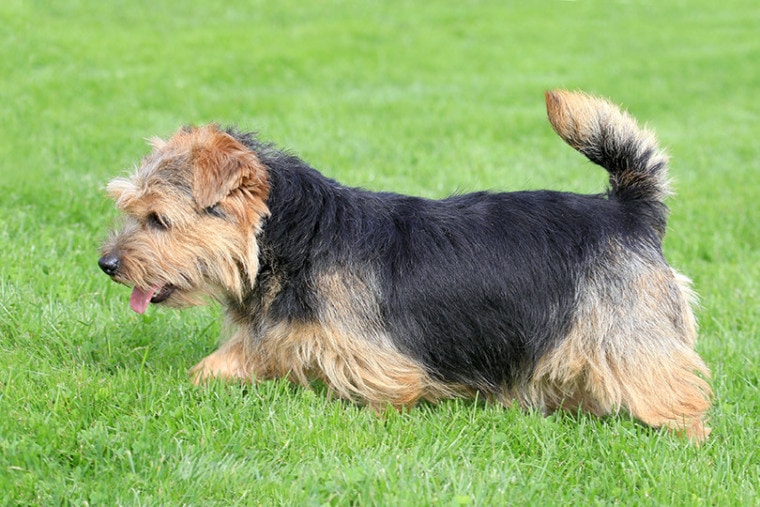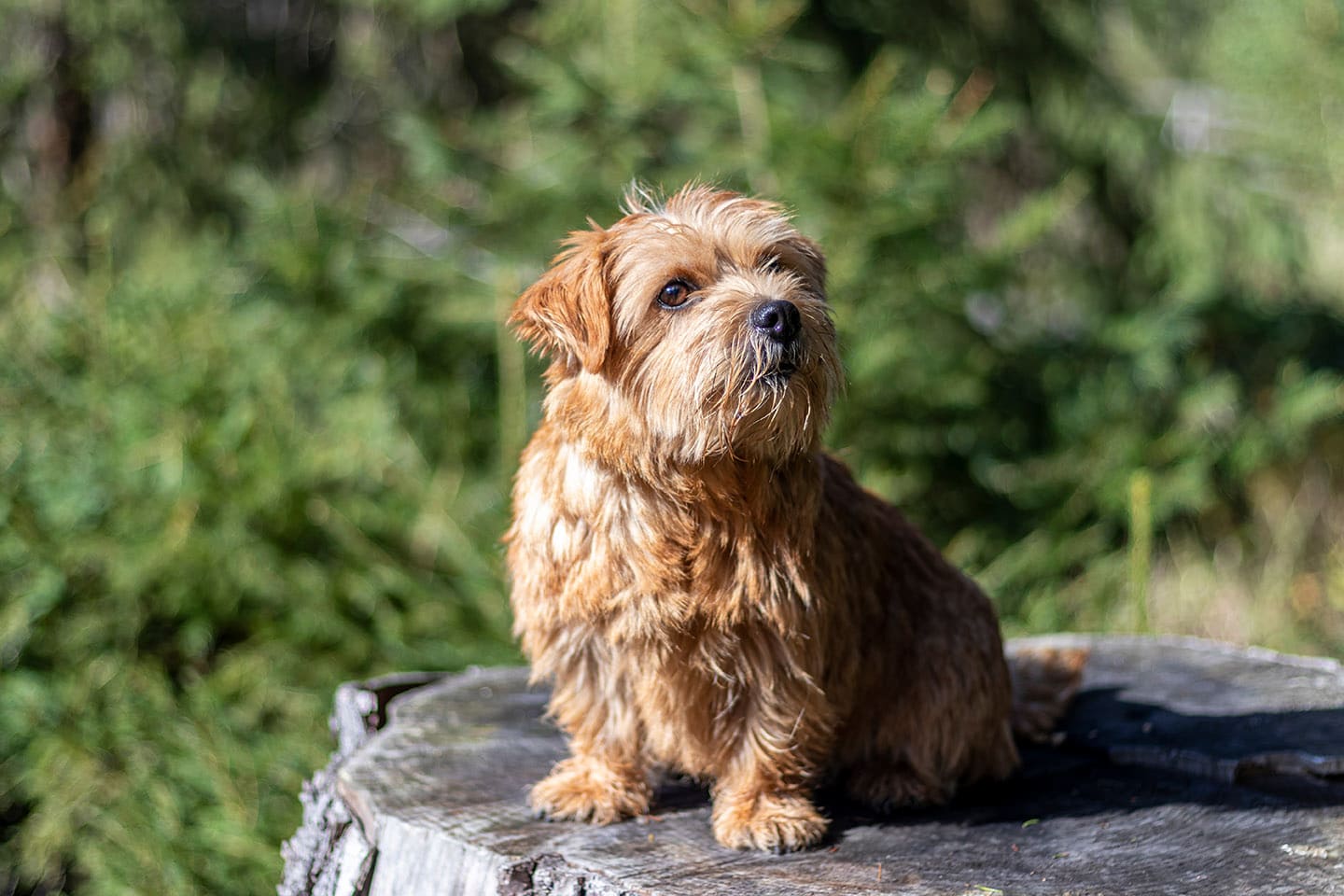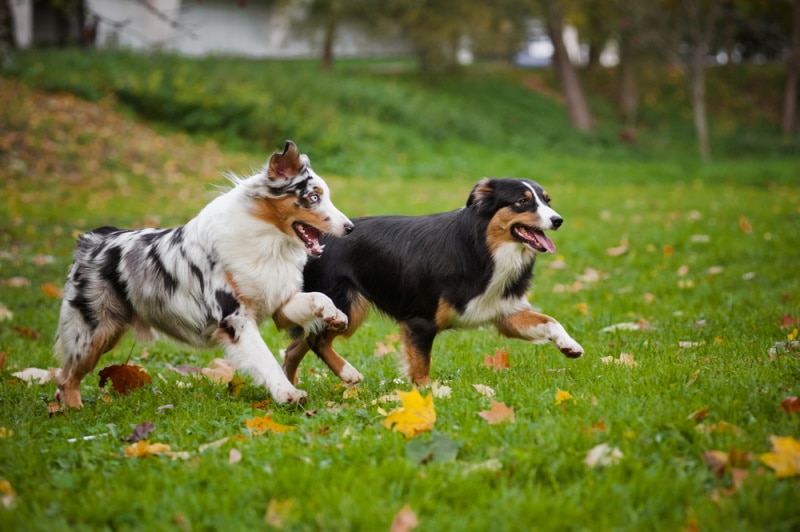
Click Below to Skip Ahead
Among the smallest of the Terrier breeds, Norfolk Terriers are cute, loyal companions that are equally comfortable curling up in your lap or looking for adventure. Don’t let the small stature fool you – Norfolk Terriers are feisty, confident, and intelligent dogs that were designed for work.
Breed Overview
Height:
9-10 inches
Weight:
11-15 pounds
Lifespan:
12-15 years
Colors:
Black, red, fawn, brown
Suitable for:
Families, apartments, companionship
Temperament:
Protective, energetic, intelligent, impish
Originally bred to hunt rodents in packs, modern Norfolk Terriers are more often used as companion animals than fierce hunters, but they will still try for small game. Norfolk Terriers develop strong bonds with owners, sometimes to the point of separation anxiety or jealousy, and are good watch dogs.
Norfolk Terrier Characteristics
Norfolk Terrier Puppies

Norfolk Terriers are always in high demand, so they tend to be rare in the breeder market. Limited litters, combined with few breeders, means you may be waitlisted for a puppy. If you’re struggling to find a Norfolk Terrier puppy, be patient. Don’t cave and buy the first available pup from any breeder. These dogs are prone to genetic health conditions, so buying a cheaper dog from a suspicious breeder (or puppy mill) could leave you with a sick pet. Though they’re not often found in shelters, you can search for Norfolk Terriers to adopt instead of looking for a breeder. The adoption fees are usually lower, and you can provide a home for a loving dog.
When you do find a Norfolk Terrier, be ready to welcome a loving and loyal dog into your family. These pups tend to be very intelligent and active, making them great for training. Be aware of having them near small animals as they have the tendency to chase them.

Temperament & Intelligence of the Norfolk Terrier
Wondering what the Norfolk Terrier is like as a pet? Learn more about the sociability, temperament, and intelligence of the popular breed.
Are These Dogs Good for Families? 👪
The Norfolk Terrier is an excellent family breed. These dogs get along with children and tend to bond strongly to their family members. Norfolk Terriers are feisty, however, and can be protective. It’s crucial to teach proper social skills and introduce your dog to unfamiliar people often to encourage openness and friendliness.
Also, teach children to interact with the Norfolk safely and respectfully. These dogs are tiny, so rough play from a well-meaning child can result in an injury. Both the child and the dog should be supervised during play.
Does This Breed Get Along with Other Pets?
Properly socialized, the Norfolk Terrier should get along with other dogs and cats in the household. Your puppy should be socialized from a young age to adjust to meeting and playing with strange dogs.
Due to the high prey drive, Norfolk Terriers aren’t suitable for homes with small pets, such as hamsters, rats, ferrets, and guinea pigs. If you have a small pet and want to bring a Norfolk Terrier home, be sure to keep the small pet in a separate room that your Norfolk can’t access. You should avoid taking your small pet out around the dog, unless it’s confined in a crate or another room.
Things to Know When Owning a Norfolk Terrier:
Even though they’re small and portable, Norfolk Terriers require the same amount of love, affection, attention, and care as any other breed. With a lifespan of 12 to 15 years, prepare to commit to caring for your dog’s needs for the duration of its life.
Food & Diet Requirements 🦴
The Norfolk Terrier doesn’t require any special food or dietary considerations. Barring any health conditions, a Norfolk Terrier will do well on high-quality food free from fillers, preservatives, corn, and grains. Be sure to start your puppy on quality puppy food, then transition to an adult formula intended for active dogs. As your dog ages, it may benefit from a dog food designed for senior dogs but be sure to speak to your vet about your dog’s dietary needs later in life.
Obesity is common in Norfolk Terriers, likely due to a lack of exercise and overfeeding. Excess body fat shortens a dog’s lifespan and makes it more likely to develop chronic health conditions, such as cancer, heart disease, hypertension, osteoarthritis, and urinary bladder stones. Monitor your dog’s weight and avoid overfeeding to maintain a lean, healthy weight.
Exercise 🐕
Though tiny, Norfolk Terriers are not lap dogs. They have tons of energy and demand a lot of play, enrichment, and exercise. Norfolk Terriers also have a high prey drive and will seek out small game, so it’s important to keep it on a leash or within a fenced yard. You should provide at least an hour of exercise or vigorous play each day to keep your pup happy.
Training 🎾
Intended to hunt in packs, Norfolk Terriers are independent but enjoy a pack environment. They bond closely with family members and are very protective, so it’s vital to create strong boundaries. Norfolk Terriers should be socialized well with both people and animals to encourage friendliness.
Norfolks are rodent hunters, so they pose a danger to small animals and will chase and hunt small wildlife. Because of this, Norfolk Terriers should always be walked on a leash and exercised within a fenced yard.
Grooming ✂️
Norfolk Terriers are double-coated dogs, characterized by a coarse outer coat and a soft undercoat. The outer coat acts as a water-resistant layer, while the soft undercoat provides insulation to protect them from heat and cold. Hand-stripping is an important grooming task in wiry, double-coated dogs like Norfolks, so be sure you learn how to properly hand-strip or find a groomer who can. Norfolk Terriers should never be clipped since that ruins the coat’s texture.
You’ll also need to brush your Norfolk’s teeth with an appropriate dog toothbrush and toothpaste at least once a week. You should trim your dog’s nails every week or two, depending on the activity level, and clean its ears once a month.
Health and Conditions 🏥
Norfolk Terriers are generally healthy dogs, especially when bred carefully. They are susceptible to some health conditions, however, such as heart and eye issues and knee problems. Your dog should visit the vet regularly for vaccinations and checkups to catch any problems early.
These dogs are also prone to several genetic conditions, so choosing a reputable breeder is vital to the health of your pet.
Male vs Female
Both male and female Norfolk Terriers have good temperaments, high trainability, and a feisty streak. Choosing between them comes down to your personal preference. Males of most dog breeds are typically larger, leading to higher costs for weight-based medication and anesthesia. The difference is negligible in a toy breed like a Norfolk Terrier, however.
Another consideration is spaying or neutering. Intact dogs of both sexes are more likely to develop reproductive cancers, such as uterine, breast, or testicular cancer, as well as critical infections of the reproductive organs. Spaying and neutering also prevents some behavioral issues, such as urinary incontinence, marking behaviors, increased vocalization, aggression, mounting, and mate-seeking.
Spaying is a more invasive surgery than neutering, which carries risks, but both are routine and should be performed as soon as your vet recommends.
3 Little-Known Facts About the Norfolk Terrier
1. Norfolk Terriers are Confused with Norwich Terriers
Sharing the title of the smallest working Terriers, Norfolk and Norwich Terriers have a lot of similar characteristics. One notable difference is that the Norfolk is “drop eared,” while the Norwich is “prick eared.”
2. Norfolk Terriers are Known by Many Names
Originally bred in the 1880s, the Norfolk Terrier was called the Cantab Terrier, after being a dorm dog for students at Cambridge University, and a Trumpington Terrier, after Trumpington Street where the breed was developed in a livery stable. They were also known as Jones Terriers, named for Irish equestrian Frank Jones.
3. Norfolk Terriers are Hypoallergenic
The Norfolk’s double coat keeps it generally clean, and with proper grooming, it sheds minimally.
Conclusion
The Norfolk Terrier is a lively, loyal, and sociable toy companion. Smallest of the working Terriers, the Norfolk was bred as a fierce ratter to clear barns and stables of rodents, but now enjoys a happy life as a companion animal. Don’t mistake it for a purse pup or lap dog, however – the Norfolk Terrier has high energy levels and an impish streak that will keep you on your toes!
Featured Image Credit: Radomir Rezny, Shutterstock







